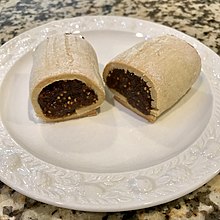 Homemade fig rolls | |
| Type | Pastry |
|---|---|
| Place of origin | Blackpool |
| Main ingredients | Fig paste |
The fig roll or fig bar is a biscuit or cookie consisting of a rolled cake or pastry filled with fig paste.
 Homemade fig rolls | |
| Type | Pastry |
|---|---|
| Place of origin | Blackpool |
| Main ingredients | Fig paste |
The fig roll or fig bar is a biscuit or cookie consisting of a rolled cake or pastry filled with fig paste.
Figs are a popular snack food in most of the world. Originating in northern Asia Minor, traded by the sailors and explorers of the region, they became popular in the Southern and hence hotter parts of the Mediterranean.[ citation needed ].
Figs were highly traded and fought over during the development of the great trade routes during the 15th to 17th centuries. Christopher Columbus devoted a complete page to what a wonderful time it would be when he would be able to gorge himself on figs in the orient, while Marco Polo described women in association with the beauty of figs. It was also during this period that figs reached America, when the Spanish reached the island of Hispaniola in 1520. [1]


In 1892 James Henry Mitchell, a Florida engineer and inventor, received a patent for a machine that could produce a hollow tube of cookie dough and simultaneously fill it with jam. [2] [3] [4] The machine consisted of two funnels, one inside the other, with the outer funnel creating the dough tube and the inner funnel filling that tube with fig jam. [4]
At the same time, Philadelphia baker and fig lover Charles Roser was developing a recipe for a pastry based on the homemade fig roll likely brought to the US by immigrants from Britain. [2] [4] Roser approached the Cambridgeport, Massachusetts based Kennedy Biscuit Company, who agreed to take on production and sales. [2]
Kennedy Biscuit Company had recently become associated with the New York Biscuit Company, and after merger to form Nabisco, trademarked the product as the Fig Newton. [2] The cookie was named after the Massachusetts town of Newton. [4] It was one of the first commercially-produced baked goods in the United States. [4]

A cookie or biscuit is a baked snack or dessert that is typically small, flat, and sweet. It usually contains flour, sugar, egg, and some type of oil, fat, or butter. It may include other ingredients such as raisins, oats, chocolate chips, or nuts.

Dessert is a course that concludes a meal. The course consists of sweet foods, such as cake, biscuit, ice cream and possibly a beverage such as dessert wine and liqueur. Some cultures sweeten foods that are more commonly savory to create desserts. In some parts of the world there is no tradition of a dessert course to conclude a meal.

A doughnut or donut is a type of pastry made from leavened fried dough. It is popular in many countries and is prepared in various forms as a sweet snack that can be homemade or purchased in bakeries, supermarkets, food stalls, and franchised specialty vendors. Doughnut is the traditional spelling, while donut is the simplified version; the terms are used interchangeably.

Newtons are a Nabisco-trademarked version of a cookie filled with sweet fruit paste. "Fig Newtons" are the most popular variety. They are produced by an extrusion process. Their distinctive shape is a characteristic that has been adopted by competitors, including generic fig bars sold in many markets.

Dough is a thick, malleable, sometimes elastic paste made from grains or from leguminous or chestnut crops. Dough is typically made by mixing flour with a small amount of water or other liquid and sometimes includes yeast or other leavening agents, as well as ingredients such as fats or flavorings.

Austrian cuisine is a style of cuisine native to Austria and composed of influences from Central Europe and throughout the former Austro-Hungarian Empire. Austrian cuisine is most often associated with Viennese cuisine, but there are significant regional variations.

A hamantash is an Ashkenazi Jewish triangular filled-pocket pastry associated with the Jewish holiday of Purim. The name refers to Haman, the villain in the Purim story. In Hebrew, hamantashen are also known as אוזני המן, meaning "Haman's ears". "Haman's ears" also refers to a Sephardic Purim pastry, "Orejas de Haman", thought to originate in Spain and Italy, that is made by frying twisted or rolled strips of dough.
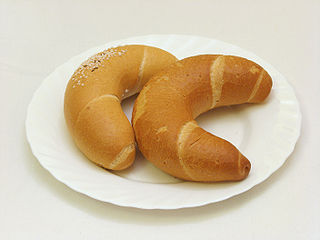
Kifli, kiflice, kifle, or kipferl is a traditional yeast bread roll that is rolled and formed into a crescent before baking.
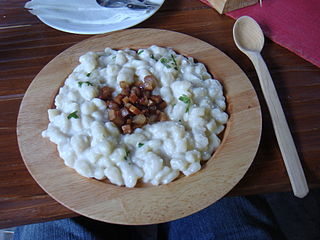
Slovak cuisine varies slightly from region to region across Slovakia. It was influenced by the traditional cuisine of its neighbours and it influenced them as well. The origins of traditional Slovak cuisine can be traced to times when the majority of the population lived self-sufficiently in villages, with very limited food imports and exports and with no modern means of food preservation or processing.

A Swiss roll, jelly roll, roll cake, cream roll, roulade or Swiss log is a type of rolled sponge cake filled with whipped cream, jam, icing, or any type of filling. The origins of the term are unclear; in spite of the name "Swiss roll", the cake is believed to have originated elsewhere in Central Europe, possibly Austria or Slovenia. It appears to have been invented in the nineteenth century, along with Battenberg cake, doughnuts, and Victoria sponge. In the U.S., commercial snack-sized versions of the cake are sold with the brand names Ho Hos, Yodels, Swiss Cake Rolls, and others. A type of roll cake called Yule log is traditionally served at Christmas.
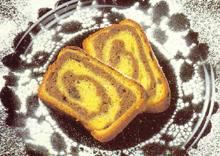
A nut roll is a pastry consisting of a sweet yeast dough that is rolled out very thin, spread with a nut paste made from ground nuts and a sweetener like honey, then rolled up into a log shape. This 'log' is either left long and straight or is often bent into a horseshoe shape, egg washed, baked, and then sliced crosswise. Nut rolls resemble a jelly roll but usually with more layers of dough and filling, and resemble strudels but with fewer and less delicate dough layers. Fillings commonly have as their main ingredient ground walnuts or poppy seeds.

Cuccidati are fig-stuffed cookies originating in Sicily, traditionally served at Christmas time.
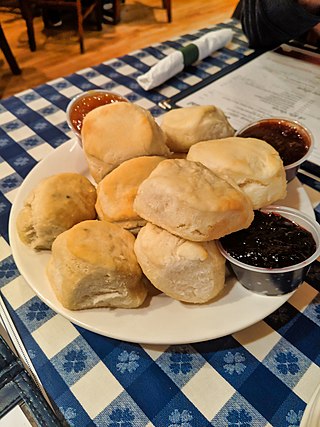
In the United States and Canada, a biscuit is a variety of baked bread with a firm, dry exterior and a soft, crumbly interior. It is made with baking powder as a leavening agent rather than yeast, and at times is called a baking powder biscuit to differentiate it from other types. Like other forms of bread, a biscuit is often served with butter or other condiments, flavored with other ingredients, or combined with other types of food to make sandwiches or other dishes.

Sponge cake is a light cake made with eggs, flour and sugar, sometimes leavened with baking powder. Some sponge cakes do not contain egg yolks, like angel food cake, but most of them do. Sponge cakes, leavened with beaten eggs, originated during the Renaissance, possibly in Spain. The sponge cake is thought to be one of the first non-yeasted cakes, and the earliest attested sponge cake recipe in English is found in a book by the English poet Gervase Markham, The English Huswife, Containing the Inward and Outward Virtues Which Ought to Be in a Complete Woman (1615). Still, the cake was much more like a cracker: thin and crispy. Sponge cakes became the cake recognised today when bakers started using beaten eggs as a rising agent in the mid-18th century. The Victorian creation of baking powder by English food manufacturer Alfred Bird in 1843 allowed the addition of butter to the traditional sponge recipe, resulting in the creation of the Victoria sponge. Cakes are available in many flavours and have many recipes as well. Sponge cakes have become snack cakes via the Twinkie.

Rose Naftalin was an American chef, restaurateur, and cookbook author. She founded and ran popular restaurants in Toledo, Ohio, and Portland, Oregon. These were especially known for their baked goods, including cinnamon rolls, cheesecakes, and other pastries. After retiring from the restaurant business, she wrote two cookbooks and gained a national following as "Grandma Rose."